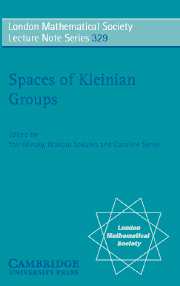Book contents
- Frontmatter
- Contents
- Preface
- Drilling short geodesics in hyperbolic 3-manifolds
- On topologically tame Kleinian groups with bounded geometry
- An extension of the Masur domain
- Thurston's bending measure conjecture for once punctured torus groups
- Complexity of 3-manifolds
- Moduli of continuity of Cannon–Thurston maps
- Variations of McShane's identity for punctured surface groups
- Train tracks and the Gromov boundary of the complex of curves
- The pants complex has only one end
- The Weil–Petersson geometry of the five-times punctured sphere
- Convexity of geodesic-length functions: a reprise
- A proof of the Ahlfors finiteness theorem
- On the automorphic functions for Fuchsian groups of genus two
- Boundaries for two-parabolic Schottky groups
- Searching for the cusp
- Circle packings on surfaces with projective structures: a survey
- Grafting and components of quasi-fuchsian projective structures
- Computer experiments on the discreteness locus in projective structures
A proof of the Ahlfors finiteness theorem
Published online by Cambridge University Press: 05 November 2011
- Frontmatter
- Contents
- Preface
- Drilling short geodesics in hyperbolic 3-manifolds
- On topologically tame Kleinian groups with bounded geometry
- An extension of the Masur domain
- Thurston's bending measure conjecture for once punctured torus groups
- Complexity of 3-manifolds
- Moduli of continuity of Cannon–Thurston maps
- Variations of McShane's identity for punctured surface groups
- Train tracks and the Gromov boundary of the complex of curves
- The pants complex has only one end
- The Weil–Petersson geometry of the five-times punctured sphere
- Convexity of geodesic-length functions: a reprise
- A proof of the Ahlfors finiteness theorem
- On the automorphic functions for Fuchsian groups of genus two
- Boundaries for two-parabolic Schottky groups
- Searching for the cusp
- Circle packings on surfaces with projective structures: a survey
- Grafting and components of quasi-fuchsian projective structures
- Computer experiments on the discreteness locus in projective structures
Summary
Introduction
The modern theory of hyperbolic 3-manifolds began with the Ahlfors Finiteness Theorem. It states that the quotient Ω(G)/G of the ordinary set of a finitely generated Kleinian group G is a finite union of surfaces, each of which is a closed surface with at most a finite number of punctures and cone points. We will formally state Ahlfors' theorem in §4. His 1964 proof [Ahl66] involved delicate analytic estimates for automorphic forms. In his enthusiasm, he forgot to rule out the possibility of infinitely many triply punctured spheres (or triangle groups more generally). The omission was soon rectified both by Bers [Ber67] with further analysis of the forms, and more elegantly by Greenberg [Gre67] using a lemma akin to Selberg's lemma. See [Gre77] and [Kra72] for expositions of these proofs. As the theory of hyperbolic manifolds developed around 1970 it was recognized that much of the proof can be carried out more simply and naturally using topological considerations [Mar74]. The topological approach was completed when the theory of the compact core and relative core was brought in, first by Kulkarni–Shalen [KS89], and then in its full implementation by Feighn–McCullough [FM87]. What then remains to do for the proof of Ahlfors' theorem is to rule out boundary components of the 3-manifold being topological disks or more generally bordered Riemann surfaces.
In the wake of Sullivan's proof of the no wandering domain theorem [Sul85] the whole shebang, especially the analytic part, became greatly simplified.
Information
- Type
- Chapter
- Information
- Spaces of Kleinian Groups , pp. 247 - 258Publisher: Cambridge University PressPrint publication year: 2006
Accessibility standard: Unknown
Why this information is here
This section outlines the accessibility features of this content - including support for screen readers, full keyboard navigation and high-contrast display options. This may not be relevant for you.Accessibility Information
- 1
- Cited by
